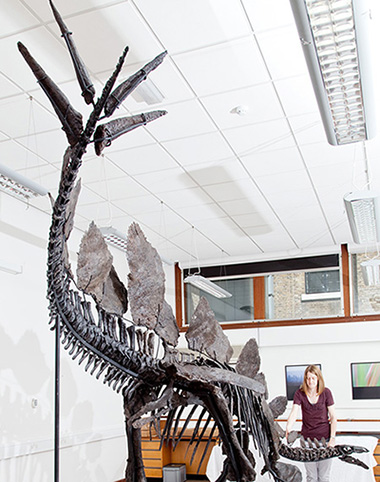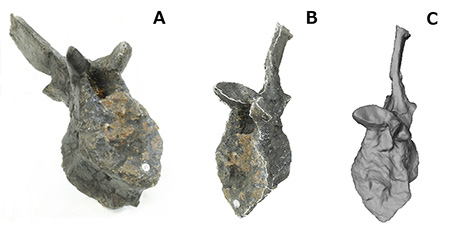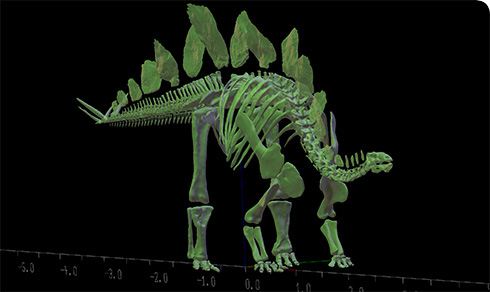Revealing the secrets of Stegosaurus: the work of a Museum scientist
It’s not just modern society that is obsessed with how much we weigh, our resident dinosaur visualisation expert Dr Charlotte Brassey has been asking this personal question about the Museum’s new Stegosaurus specimen. Here, she tells us how and why weight matters.
Our almost complete specimen of Stegosaurus stenops has been the focus of my research over the last few months.
I’m interested in biomechanics, the study of the structure and function of organisms using techniques borrowed from engineering. Many of these techniques need 3D computer models of the animal we’re studying, so my first task was to digitise the dinosaur’s skeleton.
More than 300 bones later, I have a new-found appreciation for the complexity and intricacy of the vertebrate skeleton.

The Museum’s new Stegosaurus specimen has a particularly awesome set of ornaments: 18 bony back plates and four vicious-looking tail spikes.
Creating a 3D model of Stegosaurus
The technique I use to create a 3D computer model of an animal’s skeleton is known as photogrammetry, which involves taking dozens of photographs of each bone from every possible angle. I apply a matching algorithm to find areas where photographs overlap and use this to generate a 3D model of each bone. I can then build a virtual model of the entire skeleton.
The big advantage of photogrammetry is that it doesn’t require much equipment, just a digital camera and a tripod, and the software is freely available.
Thanks to this technique, we can generate 3D models of fossils without expensive scanning equipment. We can even make reasonable 3D models out in the field using just a smartphone.

Digitising the Stegosaurus specimen. We photographed each bone, such as this tail vertebra (A), from many angles. Photogrammetry software created a ‘point cloud’ - millions of floating points representing the bone (B). These points were joined together to create a 3D representation (C).
Speed, greed and social interactions: why weight matters
Once I had built a computer model of the Stegosaurus’ skeleton, the next step was to use it to estimate its body mass and therefore weight.
I wanted to do this because an animal’s weight affects how fast it can move, how much food it must eat and how it interacts with other species, so it’s an important basic characteristic to determine.
First of all I scanned lots of skeletons of modern mammals, including elephants, rhinoceroses and deer, and generated a 3D computer model of each animal’s shape based on their skeleton. This technique is called ‘convex hulling’ and it is like stretching a rubber sheet around the skeleton. I analysed the volume of these 3D shapes and found it correlated with the body mass of living examples of the animals. So I knew the same 3D modelling approach could be applied to a dinosaur skeleton and used to predict the body mass of the dinosaur when it was alive.
Can a leg bone be enough to predict mass?
Most extinct species are only known from partial remains because the fossil record is incomplete. Palaeontologists might name a new species of dinosaur based on a single leg bone, or identify a new fossil mammal based on one tooth. This means that any estimate of the body mass of the animal will be based on limited evidence. At the Museum we were concerned this might be leading to unrealistic reconstructions of extinct species.
Fortunately, only a few parts of the Museum’s new Stegosaurus skeleton are missing, so we have been able to test this, using the 3D computer model of the dinosaur. We have estimated its body mass and weight, and compared these values to the predictions we had made based solely on the size of its leg bones.
So what were the results? Unfortunately I can’t share our findings about this dinosaur’s weight just yet as our discoveries are going to be published soon in a scientific journal. However, I can say that what we found differs considerably from the estimates we obtained based on leg bones alone, and so highlights the importance of studying near-complete fossils like this whenever the opportunity arises.
About the author

Dr Charlotte Brassey is a postdoctoral research assistant in the Earth Sciences Department, working in the field of comparative functional anatomy and biomechanics.
Toolbox
Stegosaurus-inspired events

Enjoy an exciting season of expert-led talks, workshops and evening events at the Museum to mark the dinosaur's unveiling.
